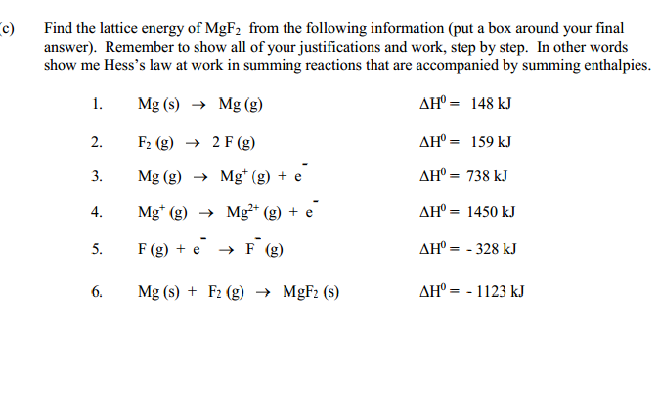

When calcium ion (Ca 2+) combines with chloride ion (Cl –), calcium chloride (CaCl 2) crystal forms, and 2195 kJ of energy is released.Ĭa 2+ (g) + 2 Cl – (g) → CaCl 2 (s) ΔH lattice = -2195 kJ/mol When calcium ion (Ca 2+) combines with oxide ion (O 2-), calcium oxide (CaO) crystal forms, and 3414 kJ of energy is released.Ĭa 2+ (g) + O 2- (g) → CaO (s) ΔH lattice = -3414 kJ/mol When sodium ion (Na +) combines with chloride ion (Cl –), sodium chloride (NaCl) crystal forms, and 787.3 kJ of energy is released. Lattice Energy Trend Lattice Energy Examples Hence, the lattice energy increases from left to right across a period and decreases from top to bottom down a group. Across a period, the atomic charge increases, and down a group, the ionic radius increases. It is clear that the bond between Na + and OH – (NaOH) has the smallest lattice energy, and that between Al 3+ and O 2- (Al 2O 3) has the greatest.įrom the above tables, one can observe that the lattice energy increases with atomic charge and decreases with ionic radius. The following table shows the lattice energies for salts of OH – and O 2. The lattice energy is proportional to the product of the two ionic charges ( ΔH lattice∝ | Q 1Q 2|). In other words, the ionic bond becomes stronger as the charge on the ions becomes large. Atomic charge: As the atomic charge increases, the lattice energy increases. It is clear that the bond between Li + and F – (LiF) has the highest lattice energy and that between Cs + and I – (CsI) has the lowest.Ģ. The following table shows the lattice energy values (in kJ/mol) for the ionic bond formed between alkali metals and halogens. In other words, the bond between opposite ions is strongest when the ions are small. Ionic radius: As the ionic radius increases, the lattice energy decreases. Lattice energy can be calculated using electrostatics or estimated from the Born-Haber cycle. MgO the higher charge on Mg leads to a larger lattice energyĦ.The lattice energy magnitude of an ionic crystal can be determined from the following equation derived from Coulomb’s law.Li 2O the higher charge on O 2– leads to a larger energy additionally, Cl – is larger than O 2– this leads to a larger interionic distance in LiCl and a lower lattice energy.MgO the higher charges on Mg and O, given the similar radii of the ions, leads to a larger lattice energy.MgO selenium has larger radius than oxygen and, therefore, a larger interionic distance and thus, a larger smaller lattice energy than MgO.The compounds with the larger lattice energy are Since the lattice energy is negative in the Born-Haber cycle, this would lead to a more exothermic reaction.Ĥ. 4008 kJ/mol both ions in MgO have twice the charge of the ions in LiF the bond length is very similar and both have the same structure a quadrupling of the energy is expected based on the equation for lattice energyĥ. The smaller the radius of the anion, the shorter the interionic distance and the greater the lattice energy would be.In the Born-Haber cycle, the more negative the electron affinity, the more exothermic the overall reaction. A higher electron affinity is more negative.The lower it is, the more exothermic the reaction will be. As in part (b), the bond energy is a positive energy.This would make the reaction more exothermic, as a smaller positive value is “more exothermic.” A lower ionization energy is a lower positive energy in the Born-Haber cycle.Since the lattice energy is negative in the Born-Haber cycle, this would lead to a more exothermic reaction. The smaller the radius of the cation, the shorter the interionic distance and the greater the lattice energy would be.Recall that the more negative the overall value, the more exothermic the reaction is. In each case, think about how it would affect the Born-Haber cycle. The answer is (d), which requires about 740 kJ/mol.ģ. U may be calculated from the Born-Haber cycle. The lattice energy, U, is the energy required to convert the solid into separate ions. We begin with the elements in their most common states, Cs( s) and F 2( g). The Born-Haber cycle shows the relative energies of each step involved in the formation of an ionic solid from the necessary elements in their reference states.


 0 kommentar(er)
0 kommentar(er)
